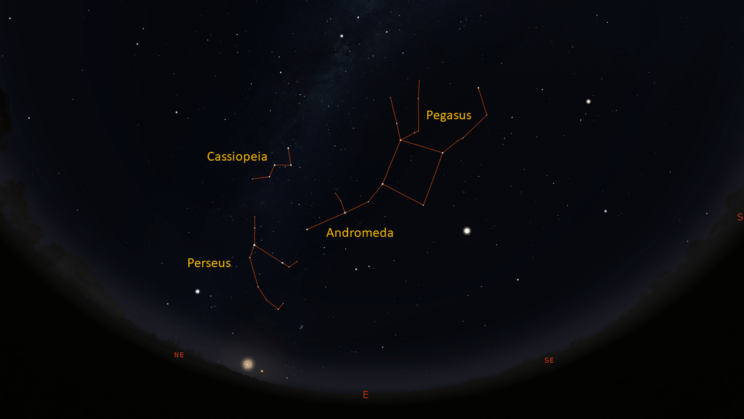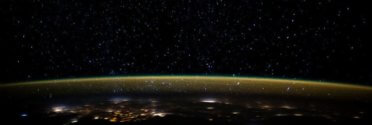This is the Saint Louis Science Center’s NIGHT SKY UPDATE for the week of Friday, September 16, 2022.
Information updated weekly or as needed.
Times given as local St. Louis time which is Central Daylight Time (CDT). For definitions of terminology used in the night sky update, click the highlighted text. If relying on times posted in Universal Time (UT), St. louis is -5 hours when CDT.
Public Telescope Viewings
Public telescope viewings at the McDonnell Planetarium have returned as part of the Saint Louis Science Center’s First Friday event. As we ease back into our telescope nights, they will operate a little different than before. To take part in our telescope viewings you will need to get a ticket for the planetarium show that starts at 7:00 p.m. as part of the First Friday event. Tickets for the First Friday planetarium show are free, but they can only be picked up at the Saint Louis Science Center on the night of the event. After the planetarium show ends you will be able to go outside and look through telescopes weather permitting. We will update this posting if anything changes.
Observing Highlight of the Week

Fall constellations seen rising around 11:00 p.m. on September 16, 2022. Image created using Stellarium.
On September 22, 2022, the Sun will cross our celestial equator at its descending node. This is the astronomical event known as the autumnal equinox marking the start of fall. Watching your nightly weather forecast, it is likely you have been hearing meteorologists already talking about the fall season. This is because meteorologists and climatologists base the seasons on annual temperature cycles and our calendar. This improves their abilities to calculate seasonal statistics which can impact various interests such as agriculture and commerce.
The autumnal equinox is an astronomical event connected to the cycle of the seasons. Visually speaking it occurs when the Sun reaches a specific position in the sky. Since ancient times, the Sun’s position was a means to track the seasons. Ancient humans observed this cycle at sites like Stonehenge and the Oyu Stones in northern Japan by watching the point of sunrise or sunset throughout the year. Numerous sites around the world have been found showing humanities connection to this astronomical cycle. Knowledge of this seasonal cycle is one of the tools that made us better farmers.
A cycle of seasons is called a tropical year which is approximately 365.242189 days long. The discovery of this consistent cycle aided the developing agrarian societies becoming the basis for most modern calendars. The most used solar calendar today is the Gregorian calendar which is only 365 days long. To accommodate the remaining .242189 days, the Gregorian calendar uses an intercalary period known as a leap year. Because the Gregorian calendar approximates a tropical year, the dates of both equinox and solstice will slowly change. Most years, the timing of an equinox or solstice happen roughly 6 hours later than the year before. The autumnal equinox can occur between the 21st and 24th of September.
Something determined by the date of the autumnal equinox is the Harvest Moon. The Harvest Moon is the full moon nearest the autumnal equinox. For 2022, the Harvest Moon occurred on September 10, 2022. Long before solar calendars, the Moon was humanities time piece. Ancient humans tracked the year by following the lunar phase cycle. This 29.5-day period is called a synodic month of which 12.4 occur each tropical year. Because of this, the dates of full moon vary. Most years, September’s full moon occurs closest to the autumnal equinox, but sometimes, October’s full moon becomes the Harvest Moon. It all depends on the date of full moons for those months. The next October Harvest Moon occurs in 2028.
Lastly, with a change in seasons comes a change in constellations. Slowly, the fall sky has been creeping into the east after sunset. Cassiopeia, Pegasus, and Andromeda are easy early evening targets. Perseus becomes easy to spot later in the evening as it clear trees. As we head through fall, a few notable meteor showers also see their peaks. The Orionids in October, and Leonids in November are two decent showers to put on your calendars.
The Sun and Moon

The Moon as seen from the International Space Station, on July 31, 2011.
Credit: NASA
Sunrise is at 6:43 a.m. on Friday, September 16 and sunset is at 7:07 p.m. providing us just under 12.5 hours of daylight. Even after sunset, the light from the Sun will dimly illuminate our sky for roughly 1 hour and 30 minutes. This period is called twilight, which ends around 8:37 p.m. this week. For those with a sundial, local noon occurs around 12:55 p.m. this week.
| Day | Sunrise | Sunset |
|---|---|---|
| 2022-09-16 | 6:43 a.m. | 7:07 p.m. |
| 2022-09-17 | 6:44 a.m. | 7:06 p.m. |
| 2022-09-18 | 6:45 a.m. | 7:04 p.m. |
| 2022-09-19 | 6:46 a.m. | 7:02 p.m. |
| 2022-09-20 | 6:47 a.m. | 7:01 p.m. |
| 2022-09-21 | 6:48 a.m. | 6:59 p.m. |
| 2022-09-22 | 6:49 a.m. | 6:58 p.m. |
| 2022-09-23 | 6:49 a.m. | 6:56 p.m. |
| 2022-09-24 | 6:50 a.m. | 6:54 p.m. |
Moon
Moonrise for Friday, September 16 occurs at 10:46 p.m. and moonset occurs at 2:20 p.m. on the following day. Friday, September 16, the Moon will exhibit a waning gibbous phase with 61% of the lunar disk illuminated. Last quarter moon occurs on September 17, 2022, at 4:52 p.m.
International Space Station (ISS) Observing

Visible passes of ISS from St. Louis for the week of September 16 occur during evening hours. The best pass this week occurs on September 17. Use the table below for information about this and other visible passes this week.
Catch ISS from St. Louis starting Friday, September 16
| Date | Starts | Max. altitude | Ends | |||||||
|---|---|---|---|---|---|---|---|---|---|---|
| Time | Alt. | Az. | Time | Alt. | Az. | Time | Alt. | Az. | ||
| 16 Sep | -2.5 | 20:32:27 | 10 | WSW | 20:35:39 | 40 | NNW | 20:37:54 | 17 | NNE |
| 17 Sep | -3.5 | 19:43:45 | 10 | WSW | 19:47:05 | 69 | NW | 19:50:27 | 10 | NE |
| 17 Sep | -0.9 | 21:22:20 | 10 | NW | 21:24:20 | 15 | NNW | 21:24:36 | 15 | NNW |
| 18 Sep | -1.3 | 20:33:04 | 10 | WNW | 20:35:35 | 19 | NNW | 20:38:07 | 10 | NNE |
| 19 Sep | -1.8 | 19:43:56 | 10 | W | 19:46:52 | 27 | NNW | 19:49:49 | 10 | NNE |
| 21 Sep | -1 | 19:44:42 | 10 | WNW | 19:46:46 | 15 | NNW | 19:48:51 | 10 | NNE |
Magnitude (Mag): The Measure of brightness for a celestial object. The lower the value is, the brighter the object will be.
Altitude (Alt): The angle of a celestial object measured upwards from the observer’s horizon.
Azimuth (Az): The direction of a celestial object, measured clockwise from an observer’s location with north being 0°, east being 90°, south being 180° and west being 270°.
For information about ISS flyovers and other visible satellites, visit www.heavens-above.com
Detailed information regarding all unmanned exploration of our universe, missions past, present, and planned, can be found at Jet Propulsion Laboratories:
The Visible Planets

Looking southeast at 9:00 p.m. September 16, 2022. Credit: Stellarium, EG

Looking south at 2:00 a.m. on September 17, 2022. Credit: Stellarium, EG
This week, three naked eye planets are visible. Mars rises before midnight but will still be best seen in the morning hours. Jupiter and Saturn are now evening targets visible not long after sunset.
Venus
Venus is ending its current morning apparition. Venus does rise before the Sun, but it has become increasingly difficult to see. About 30 minutes before sunrise, Venus is only 5° above the eastern horizon. Due to trees, many of us have already lost views of Venus. Venus reaches superior conjunction on October 22, 2022. By the end of the year, Venus will return to evening views as it starts another evening apparition.
Mars
Mars rises at 10:55 p.m. Start looking for the red planet around 12:00 a.m. as it clears trees and buildings. Mars will continue to climb out of the Sun’s glare as it heads towards opposition later this year on December 7, 2022.
Jupiter
Jupiter rises at 7:36 p.m. and should be visible in the southeast by 8:30 p.m. As the year goes on, Jupiter will rise about 25 minutes earlier than it did the week before. Jupiter will reach opposition on September 26, 2022, so our best views of this giant world will come at the end of summer and through the fall months.
Saturn
Now past opposition, Saturn rises before the Sun sets. You can find this giant world in the southeast about 45 minutes after sunset. Saturn is still a fine target though telescopes and will be a highlight of the evening sky for the rest of the year.
James S. McDonnell Planetarium
Night Sky Update: September 16 – September 24, 2022







